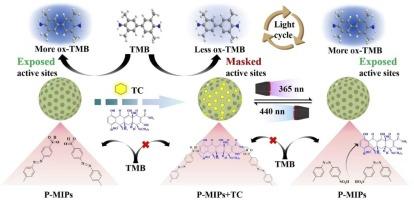Sustainable di-functional stimuli-responsive imprinted nanozymes for reversible colorimetric sensing of tetracycline
IF 8
1区 化学
Q1 CHEMISTRY, ANALYTICAL
引用次数: 0
Abstract
Regenerable nanozymes with high catalytic specificity and sustainability may serve as substitutes for naturally occurring enzymes, but their application is hindered by inadequate and nonselective catalytic activity. In this study, we constructed a photo-responsive molecularly imprinted layer on the Fe3O4 nanozyme surface (P-MIPs) using an ATRP method and obtained high-specificity reversible colorimetric sensing of tetracycline (TC). Due to the photo-responsive properties of P-MIPs, the imprinted nanozyme undergoes reversible release and uptake of TC under alternating irradiation at 365/440 nm based on the photo-regulated conformational transformation of the 4-[(4-methacryloyloxy)phenylazo] benzenesulfonic acid (MAPASA) at the polymer receptor sites, which may be confirmed by calculating the electron densities of the trans-/cis-MAPASA forms. Simultaneously, these processes can be visualized through the change in the color of the substrates. Highly specific P-MIPs-based nanozyme also exhibit adequate stability and sustainable catalytic activity after multiple cycles. This method can be used to achieve nanozymes with high selectivity for the enrichment, separation, and detection of hazardous substances and contribute to material sustainability.

用于四环素可逆比色传感的可持续双功能刺激响应印迹纳米酶
具有高催化特异性和可持续性的可再生纳米酶可作为天然酶的替代品,但其应用受到催化活性不足和非选择性的阻碍。在这项研究中,我们采用 ATRP 方法在 Fe3O4 纳米酶表面构建了光响应分子印迹层(P-MIPs),并获得了四环素(TC)的高特异性可逆比色传感。由于 P-MIPs 具有光响应特性,在 365/440 纳米波长交替照射下,基于聚合物受体位点上 4-[(4-甲基丙烯酰氧基)苯基偶氮]苯磺酸(MAPASA)的光调节构象转变,印迹纳米酶可逆地释放和吸收四环素。同时,还可以通过底物颜色的变化来观察这些过程。基于高特异性 P-MIPs 的纳米酶还表现出足够的稳定性和多次循环后的持续催化活性。这种方法可用于实现具有高选择性的纳米酶,以富集、分离和检测有害物质,并促进材料的可持续发展。
本文章由计算机程序翻译,如有差异,请以英文原文为准。
求助全文
约1分钟内获得全文
求助全文
来源期刊

Sensors and Actuators B: Chemical
工程技术-电化学
CiteScore
14.60
自引率
11.90%
发文量
1776
审稿时长
3.2 months
期刊介绍:
Sensors & Actuators, B: Chemical is an international journal focused on the research and development of chemical transducers. It covers chemical sensors and biosensors, chemical actuators, and analytical microsystems. The journal is interdisciplinary, aiming to publish original works showcasing substantial advancements beyond the current state of the art in these fields, with practical applicability to solving meaningful analytical problems. Review articles are accepted by invitation from an Editor of the journal.
 求助内容:
求助内容: 应助结果提醒方式:
应助结果提醒方式:


